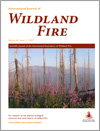International Journal of Wildland Fire
Volume 26
Number 11 2017
Our experiments reveal the carbon emission flux from the peat fire, and a non-intuitive finding that the downward smouldering spread can be faster in a wetter peat. Modelling results successfully predict the experimental observation and confirm that the oxygen supply controls peat fire behaviour in deep soil layers.
This study investigated whether time-elapsed since prior wildfire had an impact on efforts to contain a subsequent fire at the same location. Statistical analysis of data documenting the progress of fire suppression efforts in black spruce vegetation indicated that fires are more likely to escape containment as time-elapsed since the last fire increases.
The proportion of area burned with high severity did not increase over 133 years. More area burned severely early and late compared with the middle 1900s. High severity burns in the early 1900s limited the extent and severity of subsequent fires with implications for management of future large fires.
We reconstructed the fire history for south-west Colorado using alluvial-sediment methods. The fire chronology shows episodes of high- and low-severity fire over the late Holocene. Increased high-severity fires often corresponded with multi-decadal droughts, and were sometimes preceded by pluvials. A recent wildfire in the region likely contained more extensive patches of high-severity burned area than any reconstructed fires over the past 3000 years.
This study examined activity of insectivorous bats in habitats managed with dormant-season prescribed fires in eastern North American oak–hickory forests. Results demonstrated limited response in activity patterns by both high-frequency and low-frequency echolocating bats to within-stand changes in forest structure, suggesting use of prescribed fire is compatible with sustaining foraging habitat of insectivorous bats.
Five frequently repeated statements associated with empirical and physical models for predicting wildland fire behaviour are examined. The validity of each statement is discussed on the basis of information found from a review of current scientific literature.




